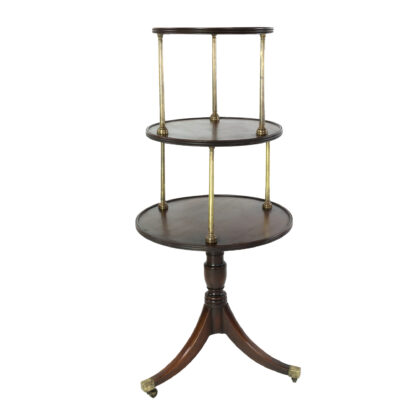  |
A Regency Brass-Mounted Mahogany Three Tier Dumb Waiter, Early 19th Century.
List: $4,500
A very good quality early 19th Century Regency Brass Mounted Mahogany three tier dumb-waiter, each circular tier surmounted on ring turned brass column supports, all raised on a tripod base terminating with original brass sabots and castors, English circa 1820. This is a wonderfully proportioned dumb waiter with a beautiful patina. [1. (Excerpted from Dumb-Waiters: Keepers of Secrets by Regency-era Historian, Kathryn Kane) Dumb-waiters were small and unobtrusive pieces of furniture which were nearly ubiquitous in Regency homes. Dumb-waiters are free-standing furniture pieces which originated in England in the early eighteenth century. They had their origins in the lavish dessert banquets of the upper classes in the early eighteenth century. By the turn of the nineteenth century, dumb-waiters could be found in the majority of the homes of the upper and middle classes where they not only served wines and tasty treats but served to protect their secrets. A favorite form of fashionable entertainment among the upper classes of England in the early eighteenth century was a fruit or sweetmeat banquet. Essentially, these were grand desserts which were set out very elegantly, usually on a long table in a large drawing room. Each tray of the glass pyramid was piled high with a wide selection of rich and colorful confections. In many fine houses, these glass serving pyramids were surrounded with flowers, which not only adorned the table, but also released delicate scents into a room lit only with dozens of candles. Plates, knives and napkins were set along the edge of the table, for the convenience of the guests, who served themselves. Most of the chairs in the room would have been pushed back against the walls and rather than being seated, the guests would stroll around the room, stopping here and there to converse with friends and acquaintances. Wines were served by several goblet boys and/or waiters, who circulated around the room with trays full of glasses, along with flasks and bottles of wine. Though most guests at these sweetmeat banquets did enjoy wine with their sweets, the presence of all those waiters and goblet boys put a considerable damper on conversation. It was well known at that time that servants were always listing for any tidbit of information they could use to blackmail the people concerned or to sell the secrets to professional blackmailers. The more embarrassing and intimate the indiscretion, the higher the price the sharp-eared servant could demand. Thus, guests at sweetmeat banquets had to mind their tongues and refrain from discussing the juicy gossip in which they were most interested. By the late 1730s, some clever furniture designer or cabinet-maker found a solution to this problem. They reinterpreted the tiered glass pyramid on a larger scale, in mahogany. This completely English furniture form was called the dumb-waiter, since it would serve in place of a human waiter. These mahogany "waiters" were both deaf and dumb, and were therefore unable to hear or tell secrets. Thus, they became popular in upper class homes, especially for sweetmeat banquets, almost overnight. Early dumb-waiters were almost always made of mahogany, the most elegant and fashionable wood of that age. They were constructed with a single, central carved or turned shaft, typically supported on three arched legs which terminated in claw and ball feet. Most of these dumb-waiters had casters attached to their feet so they could be easily moved around a room. The earliest casters were made of layers of thick leather, but by mid-century, brass casters were more common. The ornamental central shaft would support three, or sometimes four, round trays of graduated sizes, also made of mahogany, which were affixed so that they would revolve around the shaft. In addition to being beautiful and fashionable, mahogany was an exceptionally hard and strong wood which could take a very hard, smooth, high gloss polish, known in the trade as "teaboardy." This was the same type of finish which was used to finish tea trays and tea boards, since it made the wood nearly impervious to moisture and heat. Some of the trays had a raised edge, carved from the mahogany board of which the tray was made. Other trays were flat, with the addition of a raised gallery edge, usually about a couple of inches high. On these hard, glossy finished trays could be placed the wines and confections which were served at a sweetmeat banquet, thus eliminating the need for eavesdropping servants. Gossip and all the popular on-dits could then flow freely in conversation at these fashionable banquets. Dumb-waiters outlasted the fashion for sweetmeat banquets and they steadily grew in popularity though the rest of the eighteenth century. By the end of the century, they had become so popular that the form had been exported to France and other countries on the Continent, where it became known as the table servante. At the turn of the nineteenth century, dumb-waiters were a common furniture form which could be found in the homes of both the upper and middle classes of England. The country house of an old, established family might have several Georgian dumb-waiters in the dining room and other rooms of the house. More modern, Regency style dumb-waiters might be seen in a fashionable London town-house. Excerpted from Historian, Kathryn Kane, Dumb-Waiters: Keepers of Secrets, March 28, 2014, https://regencyredingote.wordpress.com/2014/03/28/dumb-waiters-keepers-of-secrets/ Although originally these trays were referred to as dumbwaiters, today they are referred to as "Lazy Susans." ]
|
|
: Tue Apr 1 0:01:06 2025 / +0000 GMT Garden Court Antiques [ https://www.gardencourtantiques.com ] Product Print by WooCommerce PDF & Print plugin. |
